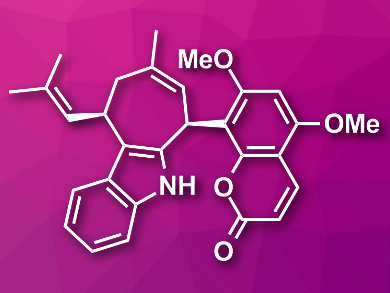Murraya plants, also called orange jasmine, have been used in traditional Chinese medicine to treat a variety of diseases. Researchers have studied these plants to find the bioactive compounds that might be responsible for any positive effects. Two such compounds, exotines A and B, were isolated from the roots of Murraya exotica.
Bichu Cheng, Harbin Institute of Technology, Shenzhen, China, and New York University, USA, and colleagues have achieved the first total synthesis of exotine B (pictured). The compound features a combination of an indole and a coumarin unit, which is rare in natural products. The team started from readily available 5,7-dimethoxycoumarin, which was iodinated and then subjected to a Suzuki cross-coupling reaction to give gleinadiene, a coumarin derivative. A three-component, Ga(OTf)3-catalyzed reaction of indole, an aldehyde, and gleinadiene gave the carbon skeleton of the natural product in a single step. The thioether group of the resulting compound was selectively oxidized, followed by a thermal elimination of the sulfoxide group to give iso-exotine B. Finally, iso-exotine B was converted to exotine B by an isomerization reaction.
The racemic exotine B synthesized by the researchers matched the reported data for the isolated natural product. In addition, according to the team, the developed synthesis of gleinadiene is an improvement over previously used methods, which require toxic mercury salts or multiple steps.
- Total Synthesis of (±)-Exotine B,
Bichu Cheng, Giulio Volpin, Johannes Morstein, Dirk Trauner,
Org. Lett. 2018.
https://doi.org/10.1021/acs.orglett.8b01817




